"Cherishing Little Steps - A Haven for Baby and Family Journeys"
Infant Bed
Are you expecting a new addition to your family? Congratulations! As you prepare for this exciting journey, one essential item you’ll need is an infant bed.
This cozy haven will provide comfort and security for your little one as they sleep and grow.
In this article, we’ll explore the benefits of using an infant bed, discuss different types available, offer safety guidelines, help you choose the right mattress, guide you in setting it up, share tips for decorating, and advise on cleaning and maintenance.
Let’s create a nurturing environment together!
Key Takeaways
- Infant beds provide a safe and comfortable environment for infants to sleep and grow.
- Using an infant bed reduces the risk of accidents or suffocation.
- Infant beds create a separate sleeping area for the baby while keeping them within arm’s reach.
- Infant beds promote healthy sleep habits for both parents and babies.
Benefits of Using an Infant Bed
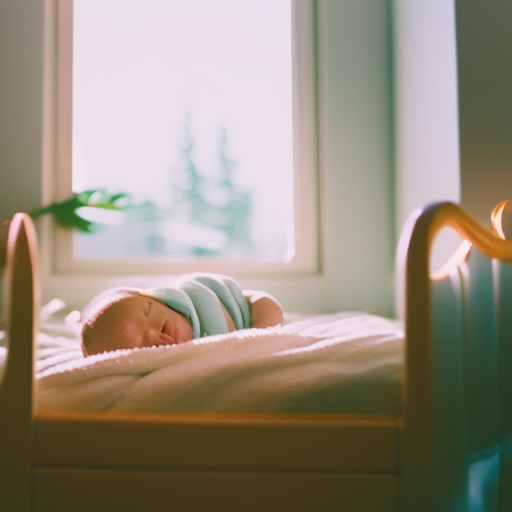
Using an infant bed can provide numerous benefits for parents and their newborns. One of the most important things for infants is getting enough sleep, as it plays a crucial role in their growth and development. By having a dedicated space for your baby to sleep, you can ensure that they have a safe and comfortable environment to rest in.
An infant bed provides a secure space where your baby can sleep undisturbed, reducing the risk of accidents or suffocation.
Co-sleeping with infants has its advantages, but it is also important to consider the potential risks associated with it. While some parents find comfort in having their baby close by during the night, studies have shown that co-sleeping increases the risk of Sudden Infant Death Syndrome (SIDS). By using an infant bed, you can create a separate sleeping area for your baby while still keeping them within arm’s reach.
Additionally, using an infant bed promotes healthy sleep habits for both parents and babies. It allows parents to have their own space and get quality rest without disrupting each other’s sleep patterns. This is especially beneficial for breastfeeding moms who need easy access to their baby during nighttime feedings.
Types of Infant Beds
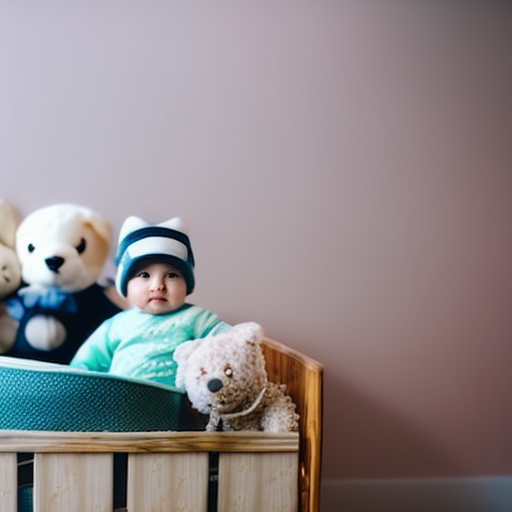
To find the best option for your little one, consider different types of cribs or bassinets. Infant beds come in various styles and designs, each with its own unique features to ensure your baby’s safety and comfort. Here are some popular infant bed types and brands to help you make an informed decision:
| Type | Brands |
|---|---|
| Convertible crib | Delta Children, Graco |
| Portable bassinet | HALO, Fisher-Price |
| Mini crib | Dream On Me, Babyletto |
| Co-sleeper | Arm’s Reach, Babybay |
Convertible cribs are a versatile choice as they can be easily transformed into toddler beds or even full-size beds as your child grows. Portable bassinets are perfect for travel or keeping your baby close by during the early months. Mini cribs are ideal for limited space while still providing a comfortable sleeping area for your little one. Co-sleepers allow you to sleep next to your baby without sharing the same bed.
When choosing an infant bed, consider factors such as safety certifications, mattress quality, and ease of assembly. Additionally, look for reputable brands that prioritize safety standards and have positive customer reviews.
Remember that every baby is different, so choose an infant bed that suits their needs and provides a secure environment for them to rest and grow.
Safety Guidelines for Infant Beds
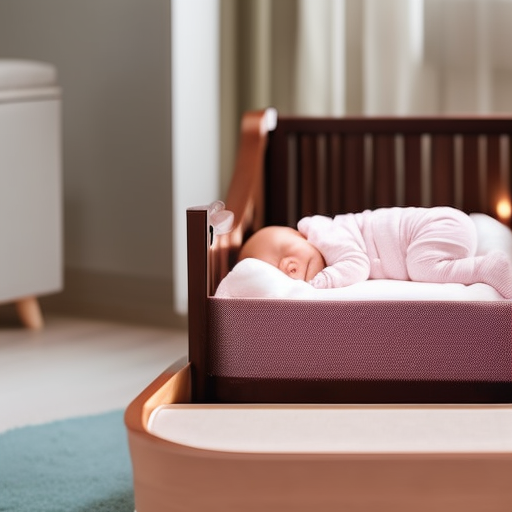
When it comes to ensuring a safe sleep environment for your little one, make sure you follow these guidelines for infant beds:
-
Safe Sleeping Positions:
-
Always place your baby on their back to sleep. This reduces the risk of suffocation.
-
Avoid placing pillows, blankets, or stuffed animals in the crib as they can pose a suffocation hazard.
-
Make sure the mattress is firm and fits snugly into the crib. A sagging or loose mattress can increase the risk of Sudden Infant Death Syndrome (SIDS).
-
Common Hazards in Infant Beds:
-
Check for any broken or missing parts in the crib. Sharp edges or loose screws can cause injuries.
-
Keep cords from blinds or curtains out of your baby’s reach to prevent strangulation hazards.
-
Ensure that there are no gaps larger than two fingers between the sides of the crib and the mattress. Your baby’s head could get trapped in these gaps.
-
Additional Safety Measures:
-
Use a fitted sheet specifically designed for cribs to avoid suffocation risks caused by loose bedding.
-
Keep mobiles and other hanging toys out of reach once your baby begins to push up on their hands and knees.
Choosing the Right Mattress for an Infant Bed
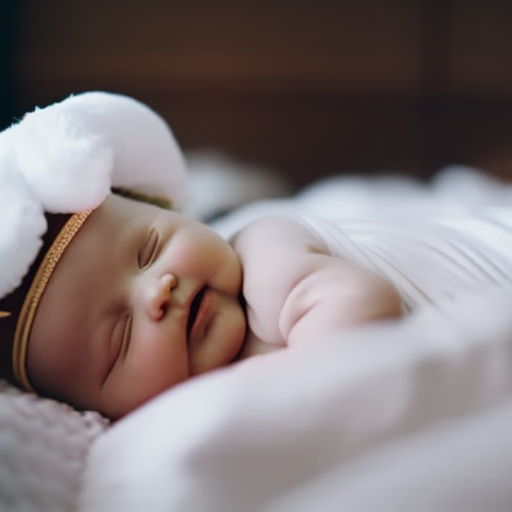
The firmness and snug fit of the mattress are crucial factors in ensuring a safe sleep environment for your little one. When choosing a mattress for your infant bed, it is important to consider certain features and materials that can provide optimal support and comfort for your baby.
Here is a table outlining some key features to look for when selecting an infant mattress:
| Feature | Description |
|---|---|
| Firmness | A firm mattress helps prevent suffocation and reduces the risk of Sudden Infant Death Syndrome (SIDS). It should not indent when your baby lies on it. |
| Waterproof Cover | Opt for a mattress with a waterproof cover, as it protects against spills, leaks, and diaper accidents. This feature also prevents the growth of mold or mildew. |
| Breathability | Look for mattresses made from breathable materials like organic cotton or natural fibers. These materials allow air circulation, reducing the risk of overheating during sleep. |
In terms of mattress materials, there are several options available: foam, innerspring coils, and organic/natural fibers such as cotton or wool. Foam mattresses are lightweight and easy to clean but may have off-gassing issues. Innerspring coil mattresses offer good support but can be heavier. Organic/natural fiber mattresses are chemical-free and hypoallergenic but tend to be more expensive.
Remember to always follow the manufacturer’s guidelines when selecting an appropriate mattress for your infant bed to ensure maximum safety and comfort for your little one.
How to Set Up an Infant Bed
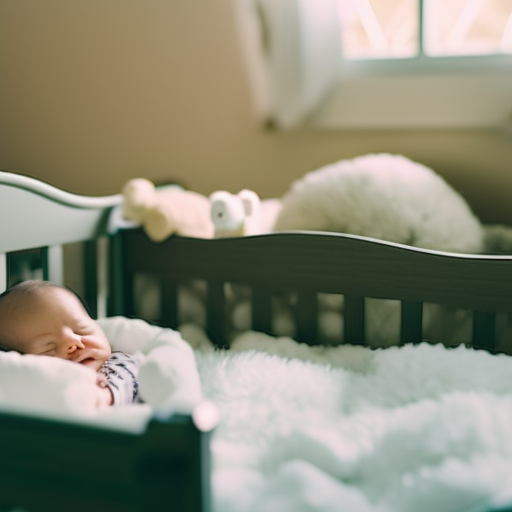
Make sure you have a safe and comfortable sleeping space for your little one by setting up their crib properly. When it comes to setting up a crib, there are a few key steps to follow:
- Choose the right location: Place the crib away from windows, blinds, cords, and other potential hazards.
- Assemble the crib correctly: Follow the manufacturer’s instructions carefully to ensure proper assembly and stability.
- Adjust the mattress height: Lower the mattress as your baby grows to prevent them from climbing out of the crib.
- Use bedding that is appropriate for an infant bed: Opt for fitted sheets that fit snugly around the mattress without any loose fabric or excess material.
Choosing bedding for an infant bed is crucial for creating a safe sleep environment:
- Select breathable materials: Look for bedding made from natural fibers like cotton or bamboo to promote airflow and reduce the risk of overheating.
- Avoid blankets and pillows: These can pose suffocation hazards, so it’s best to use sleep sacks or wearable blankets instead.
- Keep it minimal: The American Academy of Pediatrics advises against using bumper pads in cribs due to safety concerns. Stick to a fitted sheet and lightweight blanket if needed.
Tips for Decorating an Infant Bed

To create a welcoming and personalized space for your baby, consider adding decorative touches to their crib. Decorating an infant bed not only adds charm to the nursery but also stimulates your baby’s visual development.
When it comes to decorating ideas, keep in mind that simplicity is key. Opt for soft colors like pastels or neutrals as they create a soothing environment for your little one. You can choose a color scheme that complements the overall theme of the nursery or go with a more gender-neutral palette.
Adding wall decals or removable wallpaper can instantly transform the crib area and make it more visually appealing.
Another idea is to hang a mobile above the crib. Mobiles are not just decorative; they also provide visual stimulation for your baby, aiding in their cognitive development. Look for one with gentle music or soft sounds to soothe your little one during naptime or bedtime.
Additionally, consider incorporating bedding accessories such as fitted sheets and blankets that match the color scheme of the crib area. This will tie everything together and create a cohesive look.
Remember, safety should always be the top priority when decorating an infant bed. Avoid using any small objects that could pose choking hazards and ensure all items are securely attached.
Cleaning and Maintenance of Infant Beds
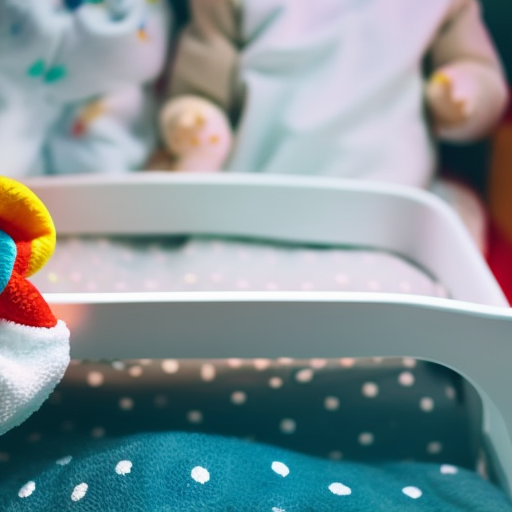
Cleaning and maintaining infant beds is essential for creating a safe and hygienic sleeping environment for your little one. Taking the time to properly clean and disinfect your baby’s bed will help prevent the spread of germs and keep your baby healthy.
Here are some cleaning techniques and disinfecting solutions you can use:
-
Regular Cleaning
-
Vacuum the mattress regularly to remove dust, dirt, and allergens.
-
Wipe down the crib frame with a gentle cleaner to remove any stains or residue.
-
Wash bedding, including sheets, blankets, and crib skirts, on a regular basis.
-
Disinfecting Solutions
-
Use a mild detergent mixed with warm water to clean plastic or wooden parts of the crib.
-
For tough stains or odors, you can use a solution of vinegar and water.
-
Consider using a bleach solution (1 part bleach to 10 parts water) for disinfecting surfaces if there has been an illness in the household.
By following these cleaning techniques and utilizing appropriate disinfecting solutions, you can ensure that your baby’s bed remains clean, comfortable, and free from harmful bacteria.
Remember to always read product labels for safety instructions when using cleaning solutions.
Transitioning From an Infant Bed to a Toddler Bed

When it’s time for your little one to transition, you’ll need to consider factors such as safety and comfort. Moving from an infant bed to a toddler bed is an important milestone in your child’s development. Toddler beds are designed with features that prioritize safety, providing a secure sleep environment for your growing child.
One of the key aspects of toddler bed safety is choosing the right bed frame. Look for a sturdy and low-profile design that minimizes the risk of falls. Ensure that the mattress fits snugly into the bed frame without any gaps, preventing entrapment hazards. It’s also advisable to have guardrails on both sides of the bed to prevent your toddler from rolling off during sleep.
Transitioning strategies can help ease this change for your little one. Start by introducing the idea of a big kid bed through books or stories. Involve them in selecting their new bedding or even decorating their room, creating excitement and ownership over their transition. Gradually introduce naps in the toddler bed before transitioning completely at night.
Frequently Asked Questions
What Is the Recommended Age for a Baby to Transition From an Infant Bed to a Toddler Bed?
The recommended age to transition from an infant bed to a toddler bed is usually around 2 to 3 years old. At this stage, your child will be more developmentally ready for the new sleeping arrangement and increased independence.
Can I Use a Regular Adult Mattress for an Infant Bed?
Yes, you can use a regular adult mattress for an infant bed. However, it is important to ensure that the mattress fits snugly and meets safety regulations and certifications to prevent any potential hazards like using crib bumpers.
How Often Should I Clean the Mattress in an Infant Bed?
To maintain a clean and safe sleeping environment for your infant, it is recommended to clean the mattress in their bed regularly. Cleaning frequency can vary, but aim for at least once every few months to remove dust, allergens, and any spills or accidents. Proper mattress maintenance is crucial for your baby’s health and comfort.
Are There Any Specific Safety Guidelines for Using Crib Bumpers in an Infant Bed?
When it comes to using crib bumpers in an infant bed, safety guidelines are crucial. Research has shown the risks associated with them, leading to controversy. It is recommended to explore alternative options for your baby’s safety.
Are There Any Regulations or Certifications I Should Look for When Purchasing an Infant Bed?
When purchasing an infant bed, it’s important to look for regulations and certifications. These ensure that the bed meets safety standards and has undergone testing. Look for labels or markings indicating compliance with industry guidelines.
Conclusion
In conclusion, the benefits of using an infant bed are numerous. It provides a safe and comfortable sleeping environment for your little one, promoting healthy growth and development. By following safety guidelines and choosing the right mattress, you can ensure that your baby is secure and well-rested.
Setting up and decorating the infant bed can also be a fun and creative process. And don’t forget about regular cleaning and maintenance to keep it hygienic.
When the time comes, transitioning from an infant bed to a toddler bed can be an exciting milestone in your child’s life. So embrace this journey with confidence and enjoy watching your little one grow!



skin allergy tablets list behind the counter allergy medicine allegra side effects
sleeping pills online order phenergan 25mg cheap
deltasone 20mg brand deltasone 20mg canada
can aspirin give you heartburn duricef tablet
strong acne medication prescription omnacortil 40mg pills buy pills to treat acne
otc allergy medication comparison chart purchase allegra sale generic allergy pills
anti acid medication prescription nsaid with least stomach problems
accutane online order order isotretinoin buy accutane 20mg for sale
amoxil sale amoxil 250mg oral buy generic amoxil for sale
virtual visit online physician belsomra modafinil tablet
azithromycin 500mg uk oral zithromax purchase zithromax generic
buy gabapentin tablets gabapentin 100mg canada
azithromycin 500mg for sale order azipro 250mg for sale order azipro 250mg
buy generic lasix online order furosemide 100mg generic
order omnacortil 40mg pill buy prednisolone 20mg generic cheap prednisolone 10mg
order monodox pill oral vibra-tabs
how to buy albuterol buy ventolin paypal order albuterol online
amoxiclav sale augmentin where to buy
buy generic levothroid synthroid 150mcg pills synthroid pills
vardenafil tablet vardenafil 20mg us
buy zanaflex pills for sale order tizanidine generic buy tizanidine 2mg sale
buy clomid 100mg generic purchase clomid pill where can i buy clomid
buy deltasone 10mg for sale oral prednisone 5mg deltasone 10mg pill
semaglutide 14 mg pill order rybelsus 14mg online semaglutide for sale online
isotretinoin 40mg drug absorica price isotretinoin 10mg sale
semaglutide 14mg canada order rybelsus sale rybelsus generic
buy ventolin inhalator for sale order generic ventolin inhalator albuterol pills
buy amoxil 1000mg pills generic amoxil 1000mg buy amoxil 250mg generic
augmentin 1000mg brand order generic augmentin buy augmentin 375mg
buy zithromax online cheap cheap azithromycin buy zithromax sale
synthroid pills cheap levothyroxine without prescription synthroid 150mcg oral
prednisolone 40mg brand order prednisolone 10mg sale order omnacortil 40mg online cheap
buy generic clomiphene clomiphene 50mg usa where to buy clomiphene without a prescription
buy generic neurontin online gabapentin 800mg sale order neurontin 800mg
lasix where to buy lasix generic buy generic furosemide
oral sildenafil sildenafil 100mg pill order sildenafil online
order vibra-tabs for sale doxycycline 100mg cheap monodox usa
rybelsus 14mg generic buy rybelsus 14 mg pills semaglutide where to buy
jackpot party casino online casino real money us blackjack game
buy generic levitra oral vardenafil vardenafil 20mg ca
pregabalin medication buy pregabalin 75mg order pregabalin online
buy generic plaquenil online plaquenil 200mg us order plaquenil 200mg
where to buy aristocort without a prescription order triamcinolone 4mg pill order triamcinolone 10mg for sale
cialis tadalafil 40mg cialis online buy tadalafil 40mg oral
clarinex 5mg ca clarinex 5mg cheap purchase desloratadine for sale
cenforce oral cenforce 100mg cheap order cenforce online
loratadine 10mg usa claritin price loratadine online
chloroquine 250mg for sale buy chloroquine 250mg online cheap order chloroquine 250mg pills
purchase xenical online buy generic xenical diltiazem 180mg cheap
buy atorvastatin 10mg online cheap buy lipitor 40mg atorvastatin 10mg uk
zovirax 400mg over the counter buy acyclovir 800mg generic zyloprim 100mg pill
amlodipine pills order norvasc without prescription buy amlodipine 10mg for sale
how to get zestril without a prescription lisinopril 5mg cost order zestril 2.5mg without prescription
crestor 20mg oral purchase crestor generic order zetia 10mg pill
buy generic omeprazole online buy prilosec 20mg online buy omeprazole for sale
domperidone over the counter buy motilium tablets buy tetracycline generic
lopressor generic order metoprolol 100mg online order lopressor
cyclobenzaprine over the counter how to buy ozobax purchase lioresal online cheap
toradol ca colcrys price colchicine 0.5mg cheap
buy cheap atenolol buy atenolol 100mg for sale tenormin uk
This post is truly a nice one it assists new internet people, who
are wishing for blogging.
Here is my web site: vpn special coupon code 2024
I’m not that much of a online reader to be honest but your blogs really nice, keep it up!
I’ll go ahead and bookmark your website to come
back later. Many thanks
my page … vpn special coupon
Greetings! Very helpful advice in this particular article!
It is the little changes that will make the greatest changes.
Thanks for sharing!
my blog post: facebook vs eharmony to find love online
Hello to every one, since I am actually keen of reading this
website’s post to be updated daily. It contains good data.
My blog post: eharmony special coupon code 2024
We’re a group of volunteers and starting a new scheme in our community.
Your site offered us with valuable info to work on. You have done an impressive job and our entire community
will be thankful to you.
Here is my blog post … nordvpn special coupon code